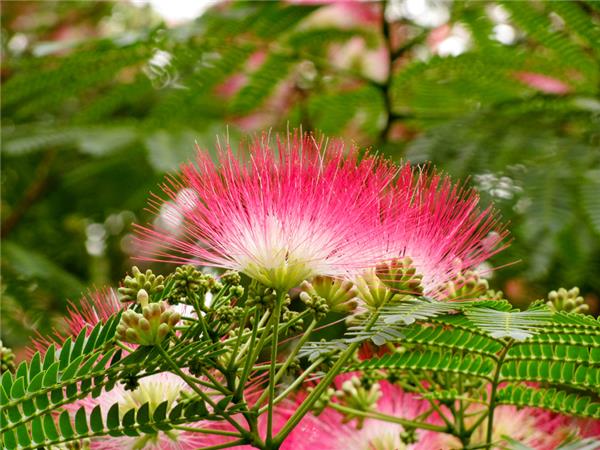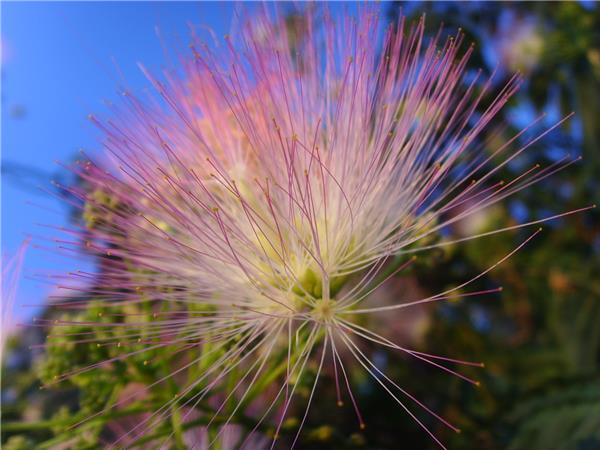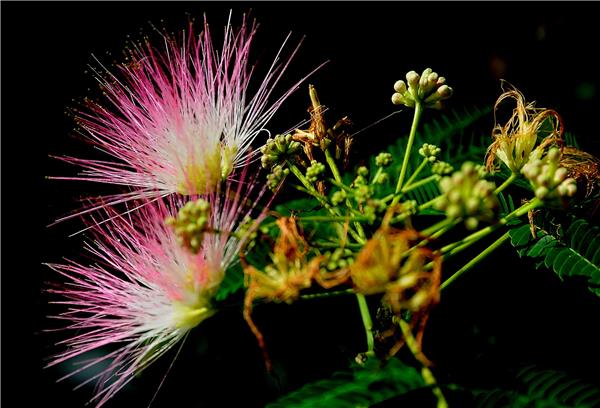Is the hibiscus tree the same as the hibiscus flower? introduction to the knowledge of hibiscus tree
When you see the hibiscus tree, do you first think of the hibiscus flower? In fact, hibiscus tree and hibiscus flower are two completely different plants. Hibiscus tree usually refers to what we usually call Hehuan. Let's learn about it.

Introduction of hibiscus tree
Morphological characteristics: hibiscus is a kind of deciduous legume tree, hibiscus is also called velvet tree. Hibiscus flowers and leaves are clear and strange, shade like umbrellas, acacia leaves as slender as feathers, beautiful flowers, shaped like fluffy balls, fragrant; Ye Qi, sunset and sunrise, giving people a symbol of friendship. Hibiscus bark grayish brown, branchlets angular. Bipinnately compound leaves alternate, pinnae 4-12 pairs; leaflets 10-30 pairs, falcate-oblong, bilateral extremely oblique, long 5~10mm, wide 1~3mm, apex extremely acute, base cuneate. Pods flat, long oval, leaves alternate, corymbose inflorescences, stamen filaments like Zoysia, half white and half red, so it is known as "Lantana" and "velvet flower".
Growth habits: hibiscus is a positive tree species, like the warm and humid environment, seedlings resistant to cold, drought. In summer hibiscus bark is not resistant to hot weather, avoid exposure to the sun, easy to molt and get sick. Albizia grows better in sandy soil and is afraid of waterlogging, so it should be drained in time and kept unobstructed. It should not accumulate water all the year round and keep plenty of sunshine.
Function and efficacy: hibiscus not only has ornamental value, but also plays a very important role in environmental protection, with strong resistance to nitrogen dioxide and certain resistance to sulfur dioxide and chlorine. And hibiscus bark and flowers can be used as medicine, with calming the mind, relieving depression, or blood pain and other effects, but also can treat fractures. Symptoms such as swelling and pain. Its fine wood structure and straight texture can be used for making furniture, architecture and so on.

Culture conditions of hibiscus tree
Propagation: hibiscus trees are generally sown and propagated, and the seeds are collected in October and sown in the spring of the following year. Hibiscus tree is not strict with the soil, likes light, is not tolerant to shade, and is not tolerant to severe cold. If there are conditions, it is advisable to choose slightly acidic loam with deep soil layer to plant albizzia. It can also grow well in barren soil. Albizia has rhizobium and has the effect of improving soil. The life span of albizzia is very long, when there is a decline in tree potential, do not like to blossom and other phenomena, you can consider to renew the plant, then avoid planting in the same place.
Sunshine: hibiscus is a yin-yang tree. It needs enough sunlight during its growth. If it is too shaded, it will lead to poor growth. Spend the winter indoors in winter.
Pruning: potted hibiscus trees should not grow too tall in order to have a good ornamental effect. When they grow taller than 20cm, they should have a big top. The branches of hibiscus trees are relatively sparse, meaning to leave more lateral buds, so that the branches grow plump and increase ornamental.

Control of common diseases and insect pests of hibiscus tree
1. Select varieties with strong disease resistance, such as light flowers, Charlotte with crimson flowers, etc., in the planting form, it is best to plant a single plant or several plants embellished in the green belt, garden and courtyard, and should not be used as street trees in large areas or on the streets. because the street soil is solid and the drainage is poor.
two。 Do a good job in the prevention of diseases and insect pests of albizzia seedlings. When the seedlings grow 3 true leaves, 2000 times solution of methamidophos is sprayed once to prevent ants and other pests from harming the seedlings, and foliar fertilizer is sprayed on the leaves regularly and quantitatively to improve the disease resistance of seedlings.
3. Reduce the number of wounds. In the daily maintenance and management, pruning as little as possible, the cutting mouth should be properly smeared with protective agent. When transplanting, it is appropriate to transplant small seedlings; when transplanting big trees, reduce the time of seedling initiation, transportation and planting, sterilize and disinfect the roots before planting, and spray 500 times of carbendazim wettable powder or 65% Dessen zinc wettable powder 500 times.
4. Pharmaceutical treatment. The diseased plants with mild symptoms should be controlled in combination with chemical treatment while changing the soil. The soil can be irrigated with conventional concentrations of pesticides such as 14.5% doxorin water-soluble powder and 40% pentachloronitrobenzene powder 300 times, once every 8 days or so, for 3 or 4 times in a row, which can effectively curb the spread of the disease and gradually restore the plant.

Here, we would also like to popularize a little knowledge: hibiscus is also the preferred tree species for earthquake observation, which is called perceptual plant. Hibiscus, as a landscaping tree, is commonly used in gardens, communities, gardens and schools. In urban greening, single planting can be courtyard trees, planted with flowers and shrubs or mixed with other tree species to form scenic forests.
- Prev

Breeding and breeding methods of hibiscus how to raise hibiscus to look good
Breeding and breeding methods of hibiscus how to raise hibiscus to look good
- Next

Detailed explanation of bonsai production and maintenance methods of jade hibiscus
Detailed explanation of bonsai production and maintenance methods of jade hibiscus
Related
- Wuhan Hospital Iron Tree Blooming Result Was Instantly Frightened by the Gardener Master
- Which variety of camellia is the most fragrant and best? Which one do you like best?
- What is the small blue coat, the breeding methods and matters needing attention of the succulent plant
- Dormancy time and maintenance management of succulent plants during dormancy
- Minas succulent how to raise, Minas succulent plant pictures
- What are the varieties of winter succulent plants
- How to raise succulent plants in twelve rolls? let's take a look at some experience of breeding twelve rolls.
- Attention should be paid to water control for succulent plants during dormant period (winter and summer)
- Watering experience of twelve rolls of succulent plants
- Techniques for fertilizing succulent plants. An article will let you know how to fertilize succulent plants.

